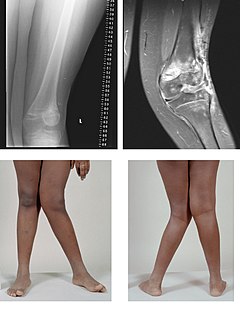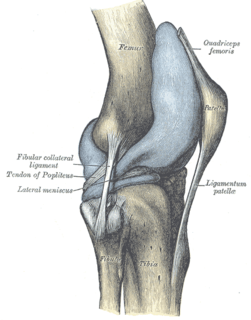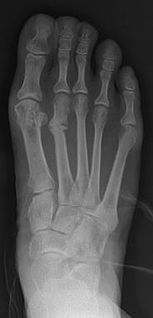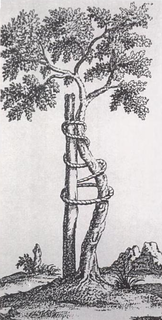
The foot is an anatomical structure found in many vertebrates. It is the terminal portion of a limb which bears weight and allows locomotion. In many animals with feet, the foot is a separate organ at the terminal part of the leg made up of one or more segments or bones, generally including claws or nails.

Toes are the digits (fingers) of the foot of a tetrapod. Animal species such as cats that walk on their toes are described as being digitigrade. Humans, and other animals that walk on the soles of their feet, are described as being plantigrade; unguligrade animals are those that walk on hooves at the tips of their toes.

A bunion, also known as hallux valgus, is a deformity of the joint connecting the big toe to the foot. The big toe often bends towards the other toes and the joint becomes red and painful. The onset of bunions is typically gradual. Complications may include bursitis or arthritis.

Pes cavus, also known as high arch, is a human foot type in which the sole of the foot is distinctly hollow when bearing weight. That is, there is a fixed plantar flexion of the foot. A high arch is the opposite of a flat foot and is somewhat less common.

A varus deformity is an excessive inward angulation of the distal segment of a bone or joint. The opposite of varus is called valgus. EX: Varus deformity results in a decreased Q angle of the knee joint.

A valgus deformity is a condition in which the bone segment distal to a joint is angled outward, that is, angled laterally, away from the body's midline. The opposite deformation, where the twist or angulation is directed medially, toward the center of the body, is called varus. Common causes of valgus knee in adults include arthritis of the knee and traumatic injuries.

Flat feet is a postural deformity in which the arches of the foot collapse, with the entire sole of the foot coming into complete or near-complete contact with the ground.
Crepitus is grating, crackling or popping sounds and sensations experienced under the skin and joints or a crackling sensation due to the presence of air in the subcutaneous tissue.

Neuropathic arthropathy, also known as Charcot joint after the first to describe it, Jean-Martin Charcot, refers to progressive degeneration of a weight-bearing joint, a process marked by bony destruction, bone resorption, and eventual deformity due to loss of sensation. Onset is usually insidious.

Tarsal tunnel syndrome (TTS), is a compression neuropathy and painful foot condition in which the tibial nerve is compressed as it travels through the tarsal tunnel. This tunnel is found along the inner leg behind the medial malleolus. The posterior tibial artery, tibial nerve, and tendons of the tibialis posterior, flexor digitorum longus, and flexor hallucis longus muscles travel in a bundle through the tarsal tunnel. Inside the tunnel, the nerve splits into three segments. One nerve (calcaneal) continues to the heel, the other two continue on to the bottom of the foot. The tarsal tunnel is delineated by bone on the inside and the flexor retinaculum on the outside.

The proximal tibiofibular articulation is an arthrodial joint between the lateral condyle of the tibia and the head of the fibula.

Hallux rigidus or stiff big toe is degenerative arthritis and stiffness due to bone spurs that affects the metatarsophalangeal joints (MTP) at the base of the hallux.
The Hubscher maneuver is a method of evaluating the flexibility of a pes planus or flat foot type. The test is performed with the patient weight bearing, with the foot flat on the ground, while the clinician dorsiflexes the hallux and watches for an increasing concavity of the Arches of the foot. A positive result results from the flatfoot being flexible. A negative result results from the flatfoot being rigid. In a Jack's test, the patient raises the rearfoot off the ground, thus passively dorsiflexing the hallux in Closed Kinetic Chain. This will result in an increase of the arch height in cases of Dynamic (Flexible) Flat Foot. If the deformity is a Static (rigid) Flat foot, the height of the arch will be unaffected by raising up the heel on the forefoot.
Foot and ankle surgery is a sub-specialty of orthopedics and podiatry that deals with the treatment, diagnosis and prevention of disorders of the foot and ankle. Orthopaedic surgeons are medically qualified, having been through four years of college, followed by 4 years of medical school to obtain an M.D. or D.O. followed by specialist training as a resident in orthopaedics, and only then do they sub-specialise in foot and ankle surgery. Training for a podiatric foot and ankle surgeon consists of four years of college, four years of podiatric medical school (D.P.M.), 3–4 years of a surgical residency and an optional 1 year fellowship.

March fracture, is the fracture of the distal third of one of the metatarsals occurring because of recurrent stress. It is more common in soldiers, but also occurs in hikers, organists, people whose duties entail much standing. March fractures most commonly occur in the second and third metatarsal bones of the foot. It is a common cause of foot pain, especially when people suddenly increase their activities.
The forefoot is the anterior aspect of the foot, composed of the five metatarsal bones, the fourteen phalanges and associated soft tissue structures. It is a common site of pathology in podiatry, and is the anatomic region involved in such conditions as hallux valgus, hallux rigidus, and Morton's neuroma, among others. In cases of severe deformity, such as in Charcot joints seen with diabetic neuropathy, the forefoot can be reconstructed by arthroplasty.

Orthopedic surgery is the branch of surgery concerned with conditions involving the musculoskeletal system. Orthopedic surgeons use both surgical and nonsurgical means to treat musculoskeletal injuries, sports injuries, degenerative diseases, infections, bone tumours, and congenital limb deformities. Trauma surgery and traumatology is a sub-specialty dealing with the operative management of fractures, major trauma and the multiply-injured patient.

Diabetic foot ulcer is a major complication of diabetes mellitus, and probably the major component of the diabetic foot.

A broken toe is a type of bone fracture. Symptoms include pain when the toe is touched near the break point, or compressed along its length. There may be bruising, swelling, stiffness, or displacement of the broken bone ends from their normal position.